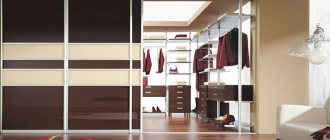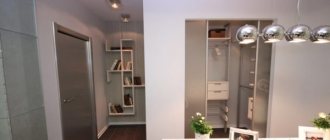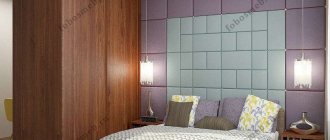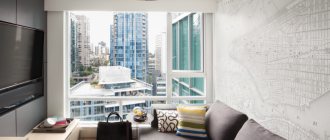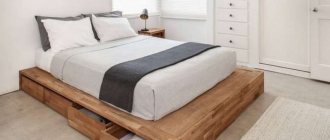0
86251
Depending on the layout of the apartment, the storage room arranged according to the project can be located next to the bedroom, corridor, or kitchen. Owners, wanting to optimize space, often come to the decision of converting the pantry into a dressing room in order to free up space in already small hallways. That is why many people think about how to make a dressing room out of a closet, which will become not just a place to store things, but a convenient storage system that meets all ergonomic requirements. For these purposes, old pantry shelves are dismantled and new structures are installed, allowing things to be placed as efficiently as possible inside the converted dressing room.
What to consider when planning?
First you need to measure the area of the pantry.
- If its size is 1x1.5 m or more, the space is suitable for arranging a dressing room.
- Now let’s decide on the location of the shelves: to install them on one side, the width of the wall should be 1.3 m. To place the shelves on both sides, 1.5 - 2 m will be required.
- The dressing room in the pantry is a closed, unventilated room. To preserve clothes, you should provide them with ventilation, and to make changing clothes easier, provide lighting.
Thus, you can turn an ordinary pantry into a dressing room even in a Khrushchev - the main thing is to take into account all the features and carefully consider the storage system.
The photo shows a small dressing room in a former storage room, separated from the bedroom by a curtain.
We allocate a place
Often such a space is provided for in the layout initially, and usually it is placed in the hallway area, but if your house does not have such a functional object, then it is worth creating it.
How to arrange a pantry? Give it one of the unused corners:
- corridor dead end;
- space above the door;
- the whole room;
- closet.
- empty niche.
The first option is good because no redevelopment work is required. Just hang the door and add shelves. A small pantry is ready!
Masonry in the corridor space
If the house has a narrow and long corridor, it can be shortened by fencing off several squares for a storage system. Here you will have to build a plasterboard partition with a door frame, and then start developing the design of the pantry.
The option of using the above-door part is, as they say, a cry from the heart. It is used only if there is simply no other alternative to getting the coveted storage room, for example, in a Khrushchev building. A mezzanine project is often implemented in the kitchen, since adapting it for something more global than storing canned goods is quite problematic.
Using the above-door part for the storage room
It is only possible to allocate an entire room for a storage room in a large house. In apartments, the most they manage to do is to take away only a small part of the living space for the object.
And the last trick in the question of how to organize a pantry: organize it inside the wardrobe in the room.
Organize your storage space inside your closet
Wardrobe system options
There are several types of “filling” for a dressing room, and each has its own advantages.
- Frame. A metal structure consisting of racks or chrome-plated pipes to which shelves and rods are fixed. The base is attached to the ceiling and floor, so the frame is very durable. This is an excellent option for a compact dressing room from a pantry, since the design does not have “extra” side walls that take up valuable centimeters.
- Panel. A storage system consisting of wide panels that are securely screwed to the wall. It is on them that shelves and drawers are attached parallel to each other.
- Mesh. A modern design consisting of lightweight metal honeycombs or gratings that are fixed to the wall using special brackets. Installation is quite simple.
- Corpus. One of the main advantages of such a system is the ability to assemble it yourself. It is sustainable and aesthetic. For each group of clothing and accessories, you can allocate its own place. Its disadvantage is that the side partitions take up useful space.
The photo shows a spacious dressing room in the pantry with a frame storage system made of light chipboard.
When choosing a storage system, it is worth considering the weight and strength of the structure - will the shelves support everything you need? In addition, you should pay attention to the mobility of the system - is it planned to be transported? Will it need modification?
The photo shows a frame structure in a pantry with open shelves, upper and lower rods, and a cabinet with drawers.
Helpful information
When thinking about how to arrange a pantry, you should not focus purely on design aspects. Properly organizing space is half the battle. Here you will still need to delve into the issues of lighting, ventilation, and humidity conditions.
Ventilation
How many design projects have you seen for closets with windows? Here! This means that the room will need forced ventilation. The ventilation system can provide this. Its presence will become an important factor in the fight against excess moisture in the air. Usually these points are thought through at the construction stage. The fact that there is a ventilation duct in the storage room in the Khrushchev house is evidenced by the ventilation hole on the wall. The latter, by the way, would not be superfluous to equip with a mosquito net. This will block insects from entering the room.
Ventilation will remove excess moisture from the air
Lighting
“The appearance of original lighting in the design of the pantry will only add coziness to the room”
Whatever mission is assigned to the pantry, it will always need high-quality lighting. To be able to see what lies deep in the shelves, use LED lighting in their design and provide powerful overhead light.
LED lighting for lighting
How can you arrange lighting for a pantry? The ceiling light bulb must be at least 150 watts. It is recommended to use lamp models with adjustable light flow direction.
You don't have to worry about wasting electricity. There won’t be any big expenses, because you don’t spend hours in this room. The appearance of original lighting in the design of the pantry will only add coziness to the room.
Bright overhead light to illuminate the pantry space
Moisture
In general, storing food in a closed pantry is not the best idea, but if you really have nowhere to put it, then at least store it in ventilated, mesh-type baskets and boxes. This will prevent moisture from accumulating in them and causing mold. The bottom of the container can be made twice “breathable” by adding an additional sheet of cardboard, plywood, or plexiglass. To reduce humidity levels, try to open the doors to such a pantry more often, and ideally not close them tightly at all.
Mesh-type boxes will prevent moisture from accumulating
How to arrange a dressing room?
After calculating the area of the room and choosing the material for the filling, you need to plan the placement of shelves and hangers in such a way that it is convenient to use the dressing room.
Location of storage systems
The choice of configuration is primarily influenced by the size of the pantry. The most compact (and less roomy) option is placement along one wall. With a well-thought-out layout of shelves and drawers, a small area will not be a problem, but will allow you to fit all your things and organize the perfect order in your mini dressing room.
If the pantry is long, then it is best to arrange the storage systems in the shape of the letter “L”. In addition to clothes and shoes, you can also store larger items in it: travel bags, clothes dryer, bulky boxes or bags with seasonal items. The width of the shelves should be such that there is a narrow distance for passage to the far corner of the dressing room.
For larger storage rooms, the optimal internal organization is in the shape of the letter “P”, when three walls are involved.
A small symmetrical pantry allows you to arrange the shelves diagonally. Triangular (corner) placement is not very functional, but sometimes it is the only way out.
The photo shows an example of placing shelves along one wall.
Dressing room lighting
An illuminated dressing room from the pantry is a completely different level of convenience than a small, dim room. Thanks to the light, using the dressing room becomes much easier and more enjoyable. One of the most budget options is an LED strip with automatic switching on when a person moves. LED lamps are very bright, safe for confined spaces, and easy to install in any convenient place.
In addition to ribbons, you can use small ceiling lamps or spotlights with a rotating mechanism. The main thing is that electrical appliances do not interfere with getting out linen and clothes.
Ventilation
The lack of circulated air in the dressing room threatens the appearance of mold, moths and unpleasant odors. Therefore, it is advisable to equip the room with ventilation. The storage room usually borders the living room, bedroom or bathroom, so for air circulation, a hole is made in the wall and covered with a grill. Air is removed through the gap under the door or the flow grille.
A more complex method is to install special devices: air vents. To do this, during renovations, professionals are invited to install a separate ventilation line in the dressing room.
Doorway design
There are several ideas to aesthetically close the opening of a dressing room made from a pantry. The most common is a swing door. Unfortunately, it takes up a lot of free space on the outside. If the opening is wide, two small doors can be used.
Sliding doors on profile guides will help save space. You can order a canvas to match the color of the walls or decorate it with a mirror.
The easiest way to close a doorway is to install a curtain rod and drape the dressing room with thick fabric to match the style of the interior.
The photo shows a dressing room converted from a storage room, the doors of which were replaced with textiles. This budget-friendly way to design an opening does not prevent it from looking stylish and aesthetically pleasing.
Selection of materials
You can purchase a ready-made wardrobe system or make it yourself. To create it yourself, the Joker system is usually used; cabinet structures are assembled or on corners from sheet materials: furniture board, plywood, chipboard. To make a choice, it is necessary to clarify the features of each method:
- Furniture system Joker for the dressing room. It consists of many pipes and connecting elements, including fasteners for chipboard panels and mirrors. Advantages: an infinite number of assembly options, the ability to rearrange parts, resistance to high loads, suitable for use on curved walls. Disadvantages: one color option for the dressing room.
- Corpus. The most common option does not require large financial costs. Advantages: a well-made design uses the entire usable area of the dressing room, less dust gets into closed niches, a variety of designs and colors. Disadvantage - the work can only be done if you have assembly experience.
- On the corners. Small furniture fasteners are used to connect two flat pieces of furniture. Advantages: variety of shapes, colors, masking of finishing defects, service life up to 100 years. Disadvantages: facades, fastened with corners, become loose over time, not very attractive appearance.
When making drawers and shelves, you can use plywood and chipboard.
To remodel a walk-in closet well, you need to choose the right materials. The optimal thickness for chipboard is 16-18 mm, for plywood - 3-30 mm, furniture panels - 16-20 mm. All of them are easy to process, easy to saw, drill, and grind. A prerequisite for particle boards is gluing the edges to the ends. Ready-made designs are complemented by containers and baskets for storing things. Compact organizers made of plastic or fabric are easy to use.
Organization of space if the dressing room is in the hallway of the apartment Joker furniture system for the dressing room. Hull
On the corners of the plywood wardrobe
From furniture board
From chipboard
Taking into account the areas in the dressing room
According to the rules of ergonomics, it is advisable to divide the interior space of the dressing room into three zones.
The topmost shelves are intended for seasonal items: hats, gloves. Unneeded outerwear is also removed there if the material allows it to be folded several times or packed in vacuum bags. A separate shelf is allocated for bed linen. Another one is for suitcases. As a rule, the higher things are located, the less often they are reached.
The middle zone is reserved for casual clothing. Rods are hung to hang dresses, blouses and suits; Shelves are installed for jackets, boxes and baskets, and drawers are installed for small items and accessories. It is convenient if there are dividers for underwear.
The lower section of the dressing room is allocated for storing shoes, bags and a vacuum cleaner. If there is not enough space for trousers in the middle zone, they can be placed below.
The photo shows a detailed description of the three functional zones of the interior space of the dressing room.
The dimensions of the shelves must be determined in advance. It happens that due to the large number of things, the standard depth and height are not suitable, then it is worth taking into account the dimensions of the previous storage location. Were there enough shelves for clothes? Did large items fit? It may be worth adding hooks or open shelves to accommodate the whole family's wardrobe.
Creation of a project and calculation of structural elements
Arranging a small dressing room requires accurate measurement of the area . Measurements are taken using a tape measure, all marks are carefully applied with a marker so that after completion of the work the marks are not noticeable. A project for the future design is drawn up, taking into account the optimal height for different storage systems:
- 20–40 cm - underwear.
- 100 cm - blouses, shirts.
- from 150 - jackets, coats, fur coats and other outerwear.
The depth of the sections in the dressing room is the size of the hangers plus 10 cm. The optimal width is determined depending on the number of items. The parameters are reflected in the drawing, which is downloaded from various resources or made manually. When arranging space in a small dressing room, it is recommended to sign where everything will be stored. This will clearly demonstrate the location of drawers and shelves. The gaps between each structural element must be indicated.
Advantages and disadvantages of mesh wardrobe systems, their features
Thanks to modern technologies, you can carefully consider the dressing room design in advance, evaluate its merits, and make changes. Special computer programs will help you organize your space correctly. The list of popular ones includes:
- Volume. Pros: simple operation, large database of materials, ability to add your own, 3D format, printer output function, high-quality graphics. The downside is that the program is paid.
- PRO100. Allows you to make a dressing room project from a small closet and arrange furniture in a specific interior. Pros: clear interface, high-quality 3D visualization, many additional tools, a base of ready-made modules, high-quality images. Cons: lack of a set of markers for positioning the part, no functionality for creating an additive map and applying edges.
- Basis Furniture Maker. The program is designed for professional drawing up of drawings and cutting maps. Pros: excellent graphic editor, automatic marker binding, creation of your own libraries, optimal schemes for arranging fasteners. Disadvantages: high cost, difficulty in developing the resource.
When creating a dressing room from a pantry, you should take into account several important nuances: the presence or absence of a mirror, the number of family members and things, the need to install lamps. All this is reflected in the plan. After completing the drawing of the dressing room, detailing is carried out - calculation of the required number of panels, fittings, as well as the scope of work: cutting, drilling, creating edges.
How to do it yourself?
When renovating, you can save a lot if you convert the pantry into a dressing room yourself.
Tools and materials
For finishing you will need:
- Roulette.
- Plaster.
- Sandpaper.
- Putty knife.
- Putty.
- Primer.
- Wallpaper with glue or paint with a roller and brushes.
- Floor covering (laminate, linoleum or parquet).
To create shelving you will need:
- Wooden boards or chipboard.
- End tape.
- Jigsaw.
- Screwdriver, dowels and screws.
- Metal furniture corners.
- A clothes rail and special fastenings at both ends.
- Hammer.
- Self-tapping screws with dowels, screwdrivers.
- Pencil.
- Level.
- Angle clamp.
The type of lighting and ventilation you choose depends on your budget and the location of your closet.
Step-by-step instruction
To make a dressing room in a pantry with your own hands, you need to follow a certain sequence. Let's get started:
- We dismantle the pantry door. We completely clean the interior space, including removing old finishing materials. If necessary, level the walls with plaster.
- We carry out finishing work. The ceiling is painted and a suitable covering is laid on the floor. The walls are covered with paint or wallpaper. It is necessary to choose modern paint compositions that do not stain clothes. Wallpaper must be washable. It is better to decorate your future dressing room in light colors. If you plan to install cabinet furniture, the finishing can be done inexpensively, since it will not be visible anyway. At this stage, ventilation and lighting are done.
- We take measurements for the manufacture of shelves. First you need to plan their location, draw a sketch, then draw up a detailed drawing. The number of shelves, rods and the dimensions of the racks depend on the real needs of the owner of the house, we will give only approximate figures: the height of the upper compartment is 20 cm, the middle one is about one and a half meters, the lower one is 40 cm. The length is determined based on the number of things and free space, the depth is in according to the size of the hanger plus 10 cm (total approximately 60 cm).
- Let's start cutting the laminated chipboard. This material is considered optimal for making a homemade shelving unit. It is not afraid of moisture and has high strength indicators. In addition, the slabs look aesthetically pleasing, imitating a wooden surface. The cutting is done with a jigsaw using sharp chipboard files. It is necessary to increase the speed, reduce the feed and set the pumping to 0. An even simpler solution is to cut it in the store when purchasing the material. Remove roughness on the edges with sandpaper.
- We fix the sides to the wall. To do this, mark vertical lines on the walls of the dressing room in accordance with the drawing. We fix 5 metal corners along the line at the same distance from each other (drill mounting holes, hammer in dowels, fix the corners with a screwdriver). We install the side panels from laminated chipboard, securing them to the corners with self-tapping screws.
- We make horizontal markings. We fix the shelves using small furniture corners: screws with dowels fix them to the wall, and wood screws to the chipboard.
- We continue to assemble the rack:
- We install the rod, securing the brackets with self-tapping screws between the two sidewalls.
- The pantry remodel is complete.
The photo shows a do-it-yourself dressing room, converted from a storage room.
Floor arrangement
The floor in such a closet is wooden, made of floor slats. The quality leaves much to be desired. It would be good to improve it so that the cleaning problem is solved more rationally. Throw a piece of linoleum inside, or upholster it with fiberboard and paint it. In our case, the floor simply became a masterpiece. A suitable part of the laminated chipboard could be adapted as a floor covering.
Floor in the pantry.
Features of organization for a small pantry
A dressing room is considered compact if it occupies only 3 square meters. To accommodate as many things as possible, you can simply turn your pantry into a large closet.
If desired, part of the walls of the storage room is demolished and the room is expanded using drywall. Unfortunately, this reduces the area of the living room, which is especially critical in a one-room apartment. The redevelopment must be legalized in the BTI.
The photo shows a pantry-wardrobe, the modest area of which does not allow for a full-fledged dressing room.
But if instead of a pantry you plan to arrange a dressing room, you need to provide a convenient passage, reduce the depth of the shelves, and provide lighting. You will most likely have to abandon built-in drawers and use a lightweight frame storage system. To use every free centimeter, you can attach additional hooks, hang textile pockets or baskets. It’s also worth leaving room for a stool so you can easily reach the top shelves.
The photo shows a compact walk-in closet located in the bedroom.
Pantry requirements
For a room to become a full-fledged dressing room, it must meet several requirements.
- A small area (up to 2 m2) will not allow you to create a convenient place for changing clothes, even if you choose a built-in type of system. The reason is the impossibility of free access to drawers and other compartments.
- The space for changing clothes must be at least 1-1.5 m2, so careful consideration of the project is often not complete without the advice of a designer who can suggest a solution in a particular case.
- Ventilation is a must, otherwise things will quickly become saturated with foreign odors and moths may appear. The worst case scenario is that mold will be discovered in the near future.
- Dividing the dressing room into zones is the optimal solution. It is better to store short and everyday items in one of them, and allocate sufficient space for seasonal outerwear - 0.5 m deep, at least 1.5 m high.
A long but narrow room is not the best option, since using the dressing room will be inconvenient, not very comfortable even psychologically. The optimal room is one that is as close to a square as possible.
Interior design ideas
It is worth paying special attention to mirrors - they will come in handy not only in a cramped dressing room, but also in a spacious room. A full-length mirror is useful when changing clothes; in addition, it visually expands the space and increases the amount of light.
The photo shows a large mirror that is mounted on the inside of the movable door, which makes it mobile and easy to use.
Another useful device is installing an ironing board in the dressing room. To do this you will need lighting, an outlet and a place for an iron.
Sometimes a dressing room in a closet becomes not only a storage place for things, but also a place for privacy, where you can put yourself in order, choose the right look, get ready for the work day or, conversely, for relaxation. This is why people all over the world value their cozy corners so much and try to furnish them with taste.
The photo shows a folding ironing board built into the wardrobe system.
Nuances of self-installation
To make a dressing room in a pantry, you need to first study all the features of its construction. If you have no experience, it is better to start with a simple option, for example, creating a storage system using Joker furniture pipes. Based on the drawn up plan, you need to calculate how many materials and connecting elements will be needed in the work. Sample list for a small storage system in a dressing room with an area of 2 square meters:
- metal pipes used as racks;
- Chipboard - shelves with drawers are made from it;
- edge tape for processing the ends of slabs;
- screws, hinges, corners.
Varieties of dressing rooms in 2 square meters. m, photos and layout ideas
To make your dressing room look stylish, you should choose chrome pipes (up to 25 mm in diameter) and laminated chipboards. The coating of the slabs can be glossy or matte. The first step is to install the frame of the future structure using rods and connecting elements. Then cut the chipboard sheets into slabs of the required size and fix them using shelf guides. At this point the main work can be considered completed.
It is worth considering that the design of the storage system is selected individually, taking into account the dimensions of the room. If the storage area does not exceed 1.5 square meters. m, it would be much wiser to make a built-in wardrobe out of it. If the niche is more than 3 square meters. m, you can use it to build a dressing room with any layout. The best option is to choose a U-shaped or L-shaped storage system.
Install the frame
Cutting chipboard sheets
Fix the shelves
Remodeling a storage room in an apartment
A small but properly organized storage room can hold a lot of things or serve as an auxiliary room (workshop, office, laundry room). When renovating a storage room in an apartment, it is important to carry out the renovation correctly, without leaving a mediocre empty area.
Wardrobe
It is advisable to use a compact room, separated in the living room or hallway, as a dressing room. There is no arguing about the usefulness of this solution - even a small pantry is more practical than a wardrobe. When arranging a dressing room, it is important to correctly distribute storage spaces for various things and objects:
- The lower shelves are used to store shoes. Drawers are convenient for storing small items and knitwear;
- the middle tier is equipped with rods for hanging winter/demi-season outerwear or summer wardrobe;
- unnecessary items or out-of-season wardrobes and hats are stored on the top tier.
Each owner chooses the depth and width of the shelves independently. The standard depth is 50-60 cm, but it will be convenient to store things on shelves 35-40 cm.
For comfortable use of the upper tiers, there should be a stool or a special stepladder in the pantry. If the area allows, you can install a mirror and allocate space for the ironing board.
Pantry-laundry
This is not a common, but very functional option for using additional space. This method is possible if it is easy to organize water supply and waste water drainage systems.
The washing machine and dryer are installed next to each other or placed one above the other - it depends on the size and shape of the pantry. To rationally use the space, storage systems for detergents and cleaning products are installed above or next to the equipment.
A fashionable trend is to install several containers for storing dirty clothes separately. This simplifies the washing process - no special pre-sorting of items is required.
Sliding mini-dryers can be placed above the washing machine or on the side for hanging small laundry items. It would be great if there is a place to store the ironing board next to the washing machine.
Pantry for storing food and kitchen utensils
Often, when planning an apartment in a Stalinist building, an area immediately next to the kitchen was allocated for a small storage room, which was very practical. A small secluded space is a great chance to unload the kitchen and conveniently arrange food supplies and kitchen utensils. How to properly organize space:
- The cereals are poured into transparent plastic jars with lids. To make the containers easier to get out, the shelves are made shallow (the best option is for 2 cans). It is better to label metal boxes;
- for storing small items (bags, bags with foil, rolls of parchment, household gloves), open plastic boxes or light wicker baskets that can simply be placed on shelves are suitable;
- It is more convenient to store pickles on the lower shelves - it is cooler and darker there;
- Kitchen appliances and utensils can be conveniently placed in drawers - it’s easier to take things out and put them back.
To store wine bottles horizontally, use special containers that are placed on shelves.
A practical solution is to attach organizers with textile or polyethylene pockets to the door leaf for storing various kitchen items.
Pantry-office
If you skillfully use the storage area, it is easy to create a cozy and comfortable workplace. Naturally, first of all, you need to equip yourself with decent lighting. The best options are a table lamp or a fluorescent lamp mounted on the wall above the table.
You should also provide enough space for a comfortable desk chair or stool. It is better to close a compact closet with sliding doors, and then it will be comfortable to sit on a chair with the doors open.
To make efficient use of space, shelves are mounted all the way to the ceiling. On the upper tiers you can place spare accessories and rarely used books.
Fashionable decor – cork and magnetic boards are modern versions of work organizers. For small rooms, you can choose comfortable computer tables equipped with stands for laptops or system units, and retractable panels for the keyboard.
Storeroom-workshop
In small apartments, a pantry is the best option to equip a workshop for hobbies. Or this is a suitable option for a freelancer to organize a workplace.
First of all, set up a comfortable work desk, well lit. It makes sense to place numerous tools on a special stand mounted on the wall above the table. The dimensions of the stand should allow you to freely reach objects without getting up from your chair.
Above the stand there are shelves for storing supplies. It is better to store all kinds of things in glass jars or transparent plastic containers.
The space under the table is allocated for drawers - it’s so convenient to see the contents and you don’t have to bend over to get items stored deep.
The original solution is small folding shelf-lattices. These auxiliary devices increase the working area and facilitate the work process.
Tool storage room
Many residents make their own repairs and are able to change the faucet or repair home appliances with their own hands. Therefore, it is not surprising that almost every home has a variety of different tools.
A storage room is a great way to separate and properly organize tools for construction repairs and equipment for repairing equipment.
Special metal racks and wall panels will make it easier to organize and maintain order in the pantry. Tools and equipment on the stands are fixed quite firmly, and the system of arrangement of objects can be formed individually.
Pantry for storing children's things
In a spacious nursery, you can also use plasterboard to enclose a corner or part of the area for storing the child’s clothes and toys. Thanks to this solution, the children's room will be freed from unnecessary things, and it will be easier for the child to put things in order. You can allocate an adjacent small room (if there is one) or part of a spacious corridor as a storage room for children's things.
The design of a small storage room in a panel house should be colorful. You can hang an original lamp on the wall, and decorate the walls with wallpaper with patterns. To make your child enjoy folding things, the boxes can be covered with colorful paper. An original idea is to use cozy, lightweight wicker baskets with lids.
When arranging things, it is necessary to take into account the height of the child. Things that are used more or less often are laid out on the lower shelves and drawers so that children can see the contents and do not have to reach for them. Toys that the child rarely plays with are placed on the top tier. You can also store spare school supplies (notebooks, albums, pens, paints) there.
Pantry as an extension of the room
Using a closet to store unnecessary things is banal and boring, especially if there is no great need for it. A creative idea is to update the pantry, decorate it in the style of the room and turn it into a library or recreation area.
To do this, a small sofa is built into the pantry, and shelves for books are mounted on the walls. To rationally use the space, drawers are installed under the sofa. The pantry opening is elegantly decorated with platbands and is not covered with door panels.
A shallow old closet can be turned into a relaxation area, entertaining guests or even a spare bedroom - just equip it with a built-in bench and a narrow mattress.

